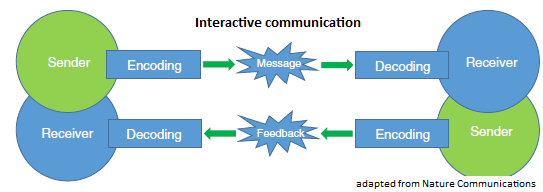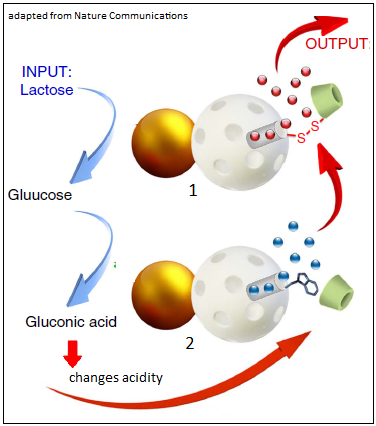Things at the nanoscale have to use nanospeak to be understood, says S.Ananthanarayanan.
Manmade devices now surpass the ability of living things in data communication and machines can send messages, act on messages received and send responses to other machines. Huge data transfer, automation and complex tasks by robots have thus become possible. The same communication capability, however, cannot be transferred to the nanoscale and this limits what use we can make of nanodevices that have become feasible.
Antoni Llopis-Lorente, Paula Díez, Alfredo Sánchez, María D. Marcos, Félix Sancenón, Paloma Matinez-Ruiz, Reynaldo Villalonga and Ramón Martínez-Máñez from institutes in Valencia and Madrid, in Spain, report in the journal, Nature Communications, that they have devised nanoparticles that use molecules, or chemical signals, for passing and receiving messages. This is the method that the smallest living things, like cells, neurons, insects and bacteria rely on, as they do not have the energy to use the methods of larger animals.
At the larger scale, the sophistication of electronics has made it possible to exercise automated, intelligent and interactive control of powerful machinery. Train control and air traffic control, for instance, or even robotics that can assemble other machines or sense defects and take steps to correct them. And the machines we use have become progressively smaller. Drones, for instance, that can fly through inaccessible areas to take pictures, or even carry out operations, in electronic communication with a control centre. While yet smaller devices are used as medical or surgical implants to carry out intelligent tasks within the bloodstream or organs of the body, it would be useful to employ drones at the level of cells, to deal with cancers, to deliver drugs or even surgery at a very fine level. At the level of very small devices, however, for measurable work, it would be necessary for groups, even swarms of nanoparticles to be in communication. The trouble is that at these dimensions, embedding electronic sensors or transmitters in the devices is not feasible.
What any system of communication calls for, the authors explain, is that a first entity respond to a stimulus by creating a signal. The signal should then be received by another entity and the receipt of the signal should act as a stimulus to a change in the state of the receiver. Ideally, the change includes sending a message back to the first sender, which needs to have the capacity to receive signals. While humans have great capacity to communicate and work in teams, animals also communicate, usually with sounds or visual signals, to hunt and to find safety in large groupings. The smallest living things, however, are too small for visual signals to be seen and they cannot create sounds that carry very far. Insects thus make extensive use of chemical signals, a method also used by other animals as ‘scents’. And the cells in the body, and single celled animals like bacteria, communicate exclusively by exchange of molecules, or chemical signals. These molecules are released when electric charges accumulate within the cells and their reception by the correspondent cell usually also brings about changes in electric charges, to set off other processes.

Jabus particles
A great deal of progress has been made in the use of chemical processes to classify information or computing. Strands of DNA, for instance, are employed to recognise chemical patterns and carry out computations. Computer memories based on protein molecules have also been conjectured. A man-made nanoparticle, of submicron dimensions, which can deliver a payload and has the capacity to send and receive chemical signals, however, has been a challenge, the authors of the Nature Communications paper say. In the work now reported, the team recognises that what is required is a particle that can respond to stimuli in two different ways, or to ‘have two faces’, so to speak. The team hence makes use of a class of ‘Janus particles’ or nanoparticles that have different physical properties on opposing faces. The same Janus particle can thus allow different chemicals processes to take place. A simplest example would be a particle that is water attracting on one side and water repelling on the other side. Such particles would align themselves along an oil-water boundary, for instance. Alternatively, they could attach to a ‘water-like’ portion of some target molecule or structure and present the water repelling side to others that approach the target.
Following this line of thinking, the Valencia-Madrid group created nanoparticles of porous silica, to one side of which nanoparticles of gold were attached. The method described is that the silica nanoparticles were first confined to a water-paraffin interface and first coated with paraffin wax on one side. Gold nanoparticles could then be attached to the face that was not covered by paraffin and the paraffin finally washed away. The result was particles that presented a silica face on one side and a gold face on the other.
The payload, or the material to be delivered was loaded in the pores of the silicon side of a first set of particles and the holes were closed with stoppers that opened when there was a specific chemical stimulus. And the gold coated side had a function that worked with a different set of stimuli. In a second set of particles, the gold side was sensitised to the signal sent by the gold side of the first set, and the response was for the silicon side to release the signal that induced the first set to release the payload. The payload was hence released when the carrier of the payload sent a message to another set of particles, and when a response was received from the other set.

As shown in the picture, the first set of particles, which carries the payload, is stimulated by the sugar, lactose. This acts on the gold side of the particles, to release the messenger, glucose. When the second set receives the messenger, it reacts by release of a second messenger, which gets the first set of particles to release the payload.
Trials were carried out with a mixture of samples of the two kinds of nanoparticles, the first one with a load. It was clearly seen that it was only when the lactose the stimulus for the first kind of particle was added to the mixture that there was progressive release of the load in the first group. The trial was hence of effective, interactive communication, based on scalable chemical exchange.
The idea of establishing communication between nanodevices embraces an enormous potential for the design of more advanced and complex nanoscale systems and the development of nanodevice communities, the authors of the paper say.
------------------------------------------------------------------------------------------